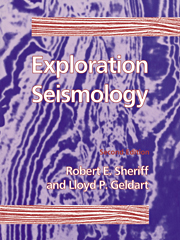Book contents
- Frontmatter
- Contents
- Preface
- Mathematical conventions and symbols
- 1 Introduction
- 2 Theory of seismic waves
- 3 Partitioning at an interface
- 4 Geometry of seismic waves
- 5 Seismic velocity
- 6 Characteristics of seismic events
- 7 Equipment
- 8 Reflection field methods
- 9 Data Processing
- 10 Geologic interpretation of reflection data
- 11 Refraction methods
- 12 3-D Methods
- 13 Specialized techniques
- 14 Specialized applications
- 15 Background mathematics
- Appendices
- Index
14 - Specialized applications
Published online by Cambridge University Press: 05 June 2012
- Frontmatter
- Contents
- Preface
- Mathematical conventions and symbols
- 1 Introduction
- 2 Theory of seismic waves
- 3 Partitioning at an interface
- 4 Geometry of seismic waves
- 5 Seismic velocity
- 6 Characteristics of seismic events
- 7 Equipment
- 8 Reflection field methods
- 9 Data Processing
- 10 Geologic interpretation of reflection data
- 11 Refraction methods
- 12 3-D Methods
- 13 Specialized techniques
- 14 Specialized applications
- 15 Background mathematics
- Appendices
- Index
Summary
Overview
Whereas the most important application of seismic methods has always been to hydrocarbon exploration, the areas of fastest growth are applications to groundwater, environmental, and engineering geophysics and to improving the economics and efficiency of coal and hydrocarbon extraction. The applications of seismic methods to nonexploration activities is the subject of this chapter.
Engineering applications
Objectives of engineering work
Seismic refraction and reflection methods give information of value to civil engineers. It is necessary to map in detail the geology, especially faulting, for the engineering of large structures such as tunnels or nuclear power plants. Mapping the depth to bedrock is the most common engineering application. Seismic studies are often used in conjunction with borehole results to interpolate between holes and reduce the number of boreholes required for an evaluation. Seismic methods are also used to map voids such as caverns and abandoned coal mines, buried channels, and shallow faults. Groundwater studies are often sufficiently similar to engineering work that the discussions in §14.1.2 and 14.1.3 apply to them also.
Most engineering interest is only in very shallow data; targets are generally shallower than 30 m, often only 10 to 15 m and sometimes only 3 m deep. Occasionally, engineering interest extends to deep data, perhaps for tunnel construction or nuclear waste disposal sites.
Both P- and S-waves are used in borehole-to-borehole studies and P- and S-wave borehole logging is used in engineering studies.
- Type
- Chapter
- Information
- Exploration Seismology , pp. 505 - 516Publisher: Cambridge University PressPrint publication year: 1995



